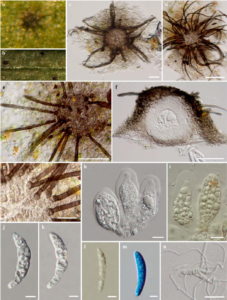Chaetothyrium agathis Hongsanan & K.D. Hyde.
Index Fungorum number: IF631614, Facesoffungi number: FoF00396; Fig. 1
Etymology – From the Latin agathis, meaning precious thing which is the genetic name of the host plant.
Holotypus – MFLU 14–0749
Saprobic on surface of leaves of Agathis. Sexual morph Ascomata 80 × 124 μm diam. (x̄ = 94 μm, n = 5), rather small, solitary or clustered (usually solitary), superficial on surface of leaves, subglobose to globose, rounded above, wall composed of pale brown cells, lacking an ostiole. Setae 62 – 107 long × 1.8 – 2.6 wide μm (x = 74 × 2 μm, n = 10), dark brown, rounded at the base and wider than apex, stellate when viewed under stereomicroscope because of setae arrangement, dark brown to black. Peridium 21 – 34 μm (x̄ = 26 μm, n = 5) comprising two cell layers of textura angularis, inner layer hyaline, outer layer brown. Hamathecium lacking paraphyses. Asci 52 – 43 × 16 – 20 μm (x̄ = 48 × 19 μm, n = 10), 8 – spored, bitunicate, fissitunicate, broadly ovoid or oblong, usually short pedicellate, with an ocular chamber. Ascospores 21 – 29 × 4 – 5 μm (x̄ = 26 × 5 μm, n = 10), 2 – 3 – seriate, oblong to ellipsoidal, with 4 – 7 trans-septa, small and narrow at both end cells, hyaline, slightly rough-walled and constricted at septum in water, rough-walled and not constricted at the septum when in Melzer’s reagent, smooth-walled and not constricted at the septum when in cotton blue reagent. Asexual morph Undetermined.
Material examined – PHILIPPINES, Laguna Province, Mount Makiling, on leaves of Agathis sp. (Araucariaceae), February 2012, K.D. Hyde HSA15 (MFLU 14–0749, holotype); ex-type living culture, MFLUCC 12–0113, CPC 20477. GenBank ITS: KP744437; LSU: KP744480.
Notes – Chaetothyrium agathis is most similar to C.brischoficola (see Chomnunti et al. 2012a; b) in having setae. The setae in C. brischoficola are however, short, while those in C. agathis are long. Ascospores of C. brischoficola are obovoid, 3 – 4-septate or muriform, while in C. agathis they are cylindrical with 3 – 7 – septate.

Fig. 1 Chaetothyrium agathis (holotype). a, b Ascomata on host surface c, d Ascomata viewed in squash mount e Ascoma with long setae around the centre. f Section through ascoma g Base of setae h Asci when immature i Asci in Melzer’s reagent with ocular chamber j, k Multi-septate, verrucose ascospores l Multi-septate ascospore in Melzer’s reagent m Ascospore in cotton blue reagent n Germinating ascospore. Scale Bars: c, d = 20 μm, e, f = 50 μm, h, i = 10 μm, j, k, l, m = 5 μm.
